

Technical Files Homepage
RGM-86 GM III Mass Production Mobile Suit (RGM-86B, -86J)
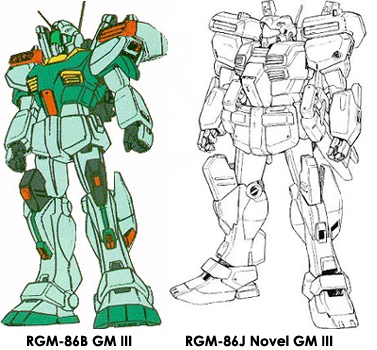
I. Dimensions:
| RGM-86B | RGM-86J | |
| Total Height: | 18.6 meters | 18.6 meters |
| Total Depth : | 5.3 meters | 5.3 meters |
| Total Breadth : | 7.5 meters | 7.6 meters |
| Dry Weight : | 19.3 metric tons | 21.1 metric tons |
| Operational Weight : | 37.3 metric tons | 39.9 metric tons |
II. Type
III. Service Use
IV. Propulsion
Engines:
(RGM-86B)
(RGM-86R)
Powerplant:
Fuel Capacity:
2O reactant for fusion engines.V. Performance
| RGM-84B | RGM-84J | |
| Running speed: | 168 kph | 177 kph |
| Max loiter time: | 180 seconds | 200 seconds |
| Jump distance:(*) | 150 meters | 180 meters |
| Cell duration:(**) | 100 hours | 100 hours |
| Acceleration: | 2.2 G | 2.1 G |
| Delta-v capacity: | 118.6 kps | 128.4 kps |
| * = Earth-normal conditions and without thrusters | ||
| ** = Continuous operational use. |
VI. Electronics
Radar tracking:
Optical tracking:
Tactical Electronic Warfare System (TEWS):
VII. Armament
Cannons
Hand Held Weapon
 1 x Rheinmetall BR-11 single-barreled tachyon rifle:
After several more years of refinement the tachyon rifle became both easier to
manufacture and maintain as well as cheaper. This lead to the first mass
deployment for the RDF of tachyon weaponry in 2055 with the RGM-85 Nemo. The
rifle represents the main weapon of the GM III and while less powerful than
platoon leader models, still packs a good punch. The rifle can fire 60 rounds per minute in full automatic mode at
approximately one shot per second. This weapon fires 200 MJ pulses, with its own dedicated cell and capacitor banks in the
'magazine' with one spare magazine mounted behind the projectile shield with a
payload of 20 shots.
1 x Rheinmetall BR-11 single-barreled tachyon rifle:
After several more years of refinement the tachyon rifle became both easier to
manufacture and maintain as well as cheaper. This lead to the first mass
deployment for the RDF of tachyon weaponry in 2055 with the RGM-85 Nemo. The
rifle represents the main weapon of the GM III and while less powerful than
platoon leader models, still packs a good punch. The rifle can fire 60 rounds per minute in full automatic mode at
approximately one shot per second. This weapon fires 200 MJ pulses, with its own dedicated cell and capacitor banks in the
'magazine' with one spare magazine mounted behind the projectile shield with a
payload of 20 shots.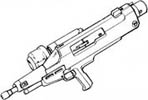 or
(after 2058) 1 x Rheinmetall BR-14 single-barreled tachyon rifle:
After several more years of refinement the tachyon rifle became both easier to
manufacture and maintain as well as cheaper. This lead to the first mass
deployment for the RDF of tachyon weaponry in 2055 with the RGM-85 Nemo. The
rifle represents the main weapon of the GM III and while less powerful than
platoon leader models, still packs a good punch. The rifle can fire 60 rounds per minute in full automatic mode at
approximately one shot per second. This weapon fires 250 MJ pulses, with its own dedicated cell and capacitor banks in the
'magazine' with one spare magazine mounted behind the projectile shield with a
payload of 18 shots.
or
(after 2058) 1 x Rheinmetall BR-14 single-barreled tachyon rifle:
After several more years of refinement the tachyon rifle became both easier to
manufacture and maintain as well as cheaper. This lead to the first mass
deployment for the RDF of tachyon weaponry in 2055 with the RGM-85 Nemo. The
rifle represents the main weapon of the GM III and while less powerful than
platoon leader models, still packs a good punch. The rifle can fire 60 rounds per minute in full automatic mode at
approximately one shot per second. This weapon fires 250 MJ pulses, with its own dedicated cell and capacitor banks in the
'magazine' with one spare magazine mounted behind the projectile shield with a
payload of 18 shots. or
1 x Three Star RU-38 360mm missile launcher: When conducting
heavy assault hit and run raids the GM III uses this large missile launcher,
a successor to the RU-35. The launcher is designed to use a
new variant of the MPM-23 similar to the old MPM-10D.
The MPM-23C is the same size as the MPM-10D,
but has a longer range and higher top speed. When not in use this weapon
can be placed on a special mount on the back of the unit freeing the hands for
other uses such as wielding the tachyon saber or a projectile shield.
The RU-38 uses an external magazine with seven rounds plus one in the chamber.
The mobile suit can reload the RU-38 in the field using and extra magazine
stored on the projectile shield of the mobile suit holding seven rounds.
or
1 x Three Star RU-38 360mm missile launcher: When conducting
heavy assault hit and run raids the GM III uses this large missile launcher,
a successor to the RU-35. The launcher is designed to use a
new variant of the MPM-23 similar to the old MPM-10D.
The MPM-23C is the same size as the MPM-10D,
but has a longer range and higher top speed. When not in use this weapon
can be placed on a special mount on the back of the unit freeing the hands for
other uses such as wielding the tachyon saber or a projectile shield.
The RU-38 uses an external magazine with seven rounds plus one in the chamber.
The mobile suit can reload the RU-38 in the field using and extra magazine
stored on the projectile shield of the mobile suit holding seven rounds.
 or
1 x Three Star 180mm electromagnetic rail cannon: When the Nemo
needs long range firepower against a variety of targets, the choice is the
180mm rail cannon. This cannon, while not as powerful as the cannon on
the RGM-85C, it still packs quite a punch and is very versatile earning it
the moniker '180mm anti-everything cannon'. The cannon fires a 110 kg
shell distances of up to 10 km with excellent accuracy thanks to self guided
shells. The available ammunition consists of KCP Kinetic Core Penetrating
(hull penetration rounds), KPI Kinetic Penetrating Incendiary (plasma
incendiary rounds) and MKEP Multiple Kinetic Energy Penetrator (flechette
cluster rounds), the latter as anti-mecha formation weapons. The
cannon carries seven shells internally in a large magazine. One spare magazine
is usually mounted under the projectile shield, however reloading this large
and cumbersome weapon takes several times as long as reloading any other
type of weapon, usually around thirty seconds.
or
1 x Three Star 180mm electromagnetic rail cannon: When the Nemo
needs long range firepower against a variety of targets, the choice is the
180mm rail cannon. This cannon, while not as powerful as the cannon on
the RGM-85C, it still packs quite a punch and is very versatile earning it
the moniker '180mm anti-everything cannon'. The cannon fires a 110 kg
shell distances of up to 10 km with excellent accuracy thanks to self guided
shells. The available ammunition consists of KCP Kinetic Core Penetrating
(hull penetration rounds), KPI Kinetic Penetrating Incendiary (plasma
incendiary rounds) and MKEP Multiple Kinetic Energy Penetrator (flechette
cluster rounds), the latter as anti-mecha formation weapons. The
cannon carries seven shells internally in a large magazine. One spare magazine
is usually mounted under the projectile shield, however reloading this large
and cumbersome weapon takes several times as long as reloading any other
type of weapon, usually around thirty seconds.
Melee Weapon
(RGM-86B)
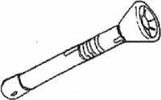 1 x Shinara 0.4 MW Tachyon Beam Saber: These
revolutionary mecha-sized melee weapon were first used on the Gundam mobile
suit. The beam saber only contains enough energy and particles for about 60
seconds of continuous use. When not in use, the beam sabers are stored in
the backpack of the mecha, where they are recharged by the GM III's reactor.
The GM III can switch the beam saber on and off while holding it, in order
to conserve power. Once totally depleted it takes 30 minutes for a beam
saber to recharge to full capacity. The GM III carries one beam saber
mounted on its backpack.
1 x Shinara 0.4 MW Tachyon Beam Saber: These
revolutionary mecha-sized melee weapon were first used on the Gundam mobile
suit. The beam saber only contains enough energy and particles for about 60
seconds of continuous use. When not in use, the beam sabers are stored in
the backpack of the mecha, where they are recharged by the GM III's reactor.
The GM III can switch the beam saber on and off while holding it, in order
to conserve power. Once totally depleted it takes 30 minutes for a beam
saber to recharge to full capacity. The GM III carries one beam saber
mounted on its backpack.(RGM-86R)
Missiles
(RGM-86B)
(RGM-86J)
Other Military Cargoes available include:
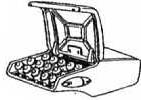 HMMP-07:
15 short range infra-red imager or passive radar homing MPM-23
Dagger high maneuverability mini missile ejection tubes, with no reloads a total
twenty fifteen missiles. Mounted on NP-WP-14 weapons
pack.
HMMP-07:
15 short range infra-red imager or passive radar homing MPM-23
Dagger high maneuverability mini missile ejection tubes, with no reloads a total
twenty fifteen missiles. Mounted on NP-WP-14 weapons
pack.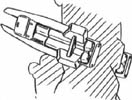 NP-WP-15: This is a
weapons pack that attaches to the hips of the RGM-86. Each
pack can mount a HMMP-08 on the pod.
NP-WP-15: This is a
weapons pack that attaches to the hips of the RGM-86. Each
pack can mount a HMMP-08 on the pod.VIII. Armor
The armor on the RGM-86 is a low-mass lunarium tungsten composite plating that is the standard for most Terran mecha. Aside from the good protection provided against projectiles, missiles, and other kinetic weapons, this armor is also resistant to plasma globes (annihilation discs), lasers, and fair against, particle guns too, owing to the fact that the armor can flake off and evaporate in layers under fire from such high-energy weapons, taking much of the weapon's energy and converting it into the latent heat of sublimation in the armor. The armor stops all small arms fire, and has good resistance to all weapons commonly mounted on combat mecha.
The GM III provides full protection from nuclear, biological, and chemical hazards, using an overpressure cockpit environment activated by radiation and hazardous chemical sensors, or manually when biological warfare conditions are anticipated. The internal consumables supplies can provide atmosphere for three days maximum.
IX. Development
The RGM-86 began development almost simultaneously with the RGM-84. However, with the cost of the movable frame being much higher than originally expected and the RDF being committed to both the Zeta Project and the completion of the Nemo, Anaheim developed the RGM-86 along more conventional lines. The design used the original GM as a design base and made modifications to several key areas. First and foremost was thrusters, both location and output. The RGM-86 featured a almost 50 percent more thrust and agility than the original GM thanks in part to backpack design first tested on the Gundam Mark II. In addition the GM III utilized the now standard linear seat and panoramic cockpit system. It also incorporated the newest fusion reactor system as well as the magnetic coating to make up for the lack of a movable frame. However, even with all of its features, the GM III still came up short in overall agility being slower on the ground than the Nemo and having inferior jump abilities though having much the same limited flight characteristics. In space the GM III was as agile as the Nemo, but on the whole, it was still inferior to the Nemo. While not as agile as the Nemo or Zeta, it was still far beyond the original GM.
To further reduce costs, the standard weapon systems were the exact same as the Nemo. It utilized the same tachyon rifle and tachyon sabers as the Nemo in addition to the standard head mounted autocannons. The GM III however did have more optional weapons than the Nemo did. These new systems were missile launchers giving the GM III the ability to serve either in the close combat role, or be loaded with extra missiles similar to a FAST pack system and be used as a mobile fire support system similar to the SDR-series destroid.
Entering service in 2055 as despite its detractors, it was proven a success in the Transient War in 2057 in which it often sat behind the front lines of Nemos and fired away with its missile launchers often a more mobile alternative to the SDR-14. As such few of the units were lost in that war. However, those that were lost were often the result of close combat, which is supposed to be the mobile suit's specialty, however the GM III often times proved to cumbersome to fight in hand to hand combat effectively, and while it could occasionally defeat male power armor, it was outclassed by the female power armor. Following the war, the RGM-86 received and upgrade. The RGM-86J Novel GM III as it became known had improved engines as well as the Nemo Plus' tachyon rifle and a more powerful tachyon saber. It added a smaller, enclosed chest launcher which allowed the mobile suit to be more effective at close range combat, but could still use the same optional systems as the original GM III. The RGM-86J served in the front lines with good service record and it was replaced in 2062 by the RGM-91 ReGZ which, while having less missiles was more effective in close combat.
Layout adapted from Robotech Reference Guide
Content by Jeffrey R. Spillner
and Ron Ferrara
Copyright © 1998-2001 Jeffrey R. Spillner, Ron Ferrara
Page Last Updated on February 22, 2001 @ 00:00 GMT